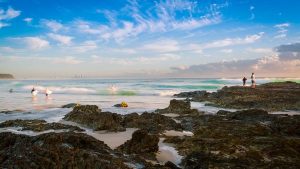Gold Coast maintained its status as the ultimate playground for visitors as new tourism figures show a combined $5.9 billion was injected into the economy, for the year ending September 2019.

National Visitor Survey* (NVS) and International Visitor Survey* (IVS) released today show the Gold Coast continued to prosper, as total expenditure increased 8.7 per cent.
A total 13.9 million international, domestic overnight and daytrip visitors came to play in Australia’s favourite playground, up 13.2 per cent for the year.
Destination Gold Coast CEO Annaliese Battista said the Gold Coast continues to attract high-spending travellers as part of its targeted approach to grow the visitor economy.
“This strong growth is primarily driven by a resurgence in domestic travel from our core visitor markets of Brisbane, Sydney and Melbourne,” said Ms Battista.
“Domestic overnight expenditure increased 14 per cent to $3.7 billion and visitors were up 13.6 per cent to 4.1 million.
“Growth in both spend and visitation is performing better than most parts of Queensland and Australia as we have seen more recently.”
A further 8.7 million also took a daytrip to the Coast accounting for $809.5 million in spend, an increase of almost 15 per cent and 4 per cent respectively – both were record figures.
Brisbane overnight visitors increased 23.4 per cent to 1.4 million, Sydney attracted 673,000, up 11.7 per cent and a record 428,000 Melbournians flocked to the Coast, up 16.5 per cent year-on-year.
“Increasing domestic market share through our marketing, which unapologetically plays to Gold Coast’s strengths, is paying off,” said Ms Battista.
“Australia is responding to our call to come and play on our beaches, in the hinterland and at our theme parks and other attractions.
“Visitation has significantly increased across our core source markets, with all achieving double digit growth.”
International visitor expenditure decreased marginally by 1.1 per cent to $1.3 billion, while visitor numbers remained steady at 1.1 million.
The Coast’s top three international source markets of China, New Zealand and Japan all experienced growth.
Ms Battista said ten million nights were spent on the Gold Coast as overseas visitors continued to savour the region’s world-famous experiences.
“A resurging Japanese market attracted 70,000 arrivals, up 3.7 per cent and a record 45,000 Americans, up 9.7 per cent show an upward trend that is likely to continue.
“These source markets are likely to continue to deliver strong growth in the coming year as flights into Brisbane Airport via San Francisco, Chicago and Tokyo are scheduled to take-off in the first half of 2020,” Ms Battista said.
Total Gold Coast Visitors Overview (for 12 months to September 2019)
| Total Visitation | Total Spend |
| 13.9m (+13.2%) | $5.9B (+8.7%) |
Domestic Overnight Visitors (for 12 months to September 2019)
| Total Visitors | Total Spend | |
| Australia | 115.7m (+12.3%) | $79.1B (+13.3%) |
| Queensland | 25.7m (+13.7%) | $19B (+9.4%) |
| Gold Coast | 4.1m (13.6%) | $3.7B (+14%) |
| GC Daytrippers | 8.7m (+14.9%) RECORD | $809.5m (+3.9%) RECORD |
Gold Coast Domestic Overnight Visitors (for 12 months to September 2019)
| Total Overnight Visitation | Total Overnight Spend | Total Nights | ALOS |
| 4.1m (+13.6%) | $3.7B (+14%) | 15.4m (+14.1%) | 4.0 nights |
International Visitors (for 12 months to September 2019)
| Total Visitors | Total Spend | |
| Australia | 8.7m (+2.5%) | $31.3B (+5.0%) |
| Queensland | 2.8m (-0.5%) | $6B (+1.7%) |
| Gold Coast | 1.1m (+0.1%) | $1.3B (-1.1%) |
Top 5 source markets (for 12 months to September 2019)
| China | 273,000 (+1.3%) |
| New Zealand | 210,000 (+0.8%) |
| Japan | 70,000 (+3.7%) |
| United Kingdom | 60,000 (-6.5%) |
| USA | 45,000 (+9.7%) RECORD |
Gold Coast International Visitors Overview (for 12 months to September 2019)
| Total Visitation | Total Spend | Total Nights | ALOS |
| 1.1m (+0.1%) | $1.3B (-1.1%) | 10m (+4.6%) | 9.5 nights (+0.4n) |
* Visitor data is provided by International Visitor Surveys (IVS) and National Visitor Surveys (NVS) conducted by Tourism Research Australia for each quarter. This release of September 2019 data includes a data collection transition for the NVS from landline sampling to 100% mobile phone interviewing from January 2019, resulting in an unavoidable break in the series between 2018 and 2019 NVS data. Please use caution when making comparisons between 2019 and previous estimates, as the change in survey methodology is likely to affect results. See International Visitor Survey and National Visitor Survey methodology for further information.















